OCZ's Vertex 2 Pro Preview: The Fastest MLC SSD We've Ever Tested
by Anand Lal Shimpi on December 31, 2009 12:00 AM EST- Posted in
- Storage
PCMark Vantage - A New Leader
The Vertex 2 Pro’s dominance doesn’t stop in the synthetic tests - we have a new winner in PCMark Vantage.
While I don’t like Vantage much as a CPU benchmark, it is one of the best real world indicators of SSD performance. Far better than a lot of the synthetic tests that are used by most. Performance in Vantage isn’t all that matters, but as a part of a suite it’s very important.
Luckily for OCZ and SandForce, the Vertex 2 Pro doesn’t disappoint here either. As a testament to how much they have their act together, I didn’t have to tell SandForce what their Vantage scores were - they already use it as a part of their internal test suite. This is in stark contrast to other newcomers to the SSD market that were surprised when I told them that their drives don’t perform well in the real world.
The Vertex 2 Pro is 6% faster than the X25-M G2 in the overall PCMark Vantage test and 12% faster in the HDD specific suite. It’s at the borderline for what’s noticeable in the real world for most users but the advantage is there.

The memories suite includes a test involving importing pictures into Windows Photo Gallery and editing them, a fairly benign task that easily falls into the category of being very influenced by disk performance.
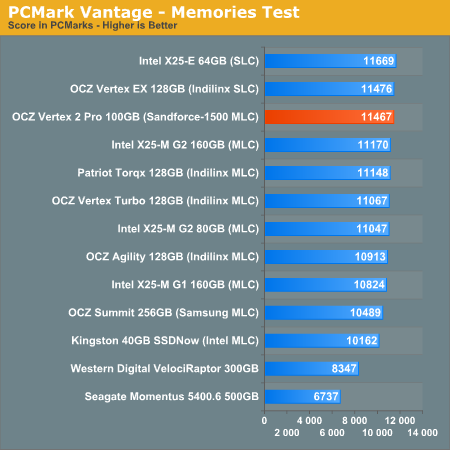
The TV and Movies tests focus on on video transcoding which is mostly CPU bound, but one of the tests involves Windows Media Center which tends to be disk bound.
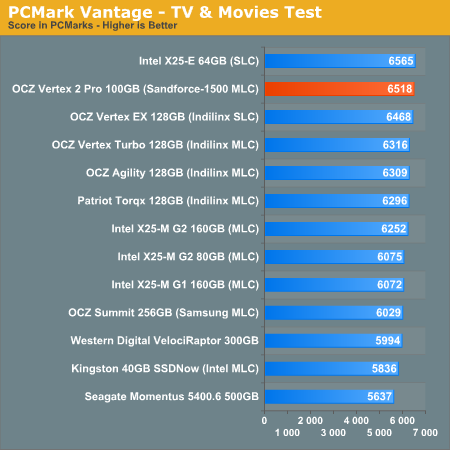
The gaming tests are very well suited to SSDs since they spend a good portion of their time focusing on reading textures and loading level data. All of the SSDs dominate here, but as you'll see later on in my gaming tests the benefits of an SSD really vary depending on the game. Take these results as a best case scenario of what can happen, not the norm.
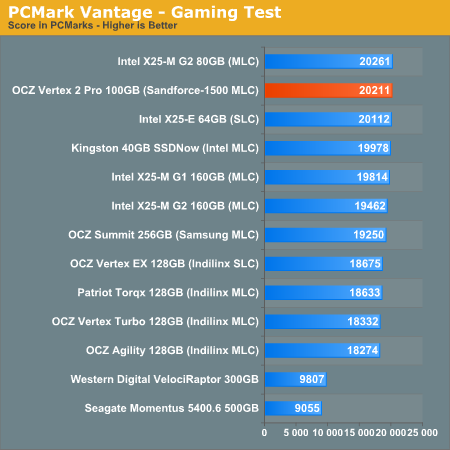
In the Music suite the main test is a multitasking scenario: the test simulates surfing the web in IE7, transcoding an audio file and adding music to Windows Media Player (the most disk intensive portion of the test).
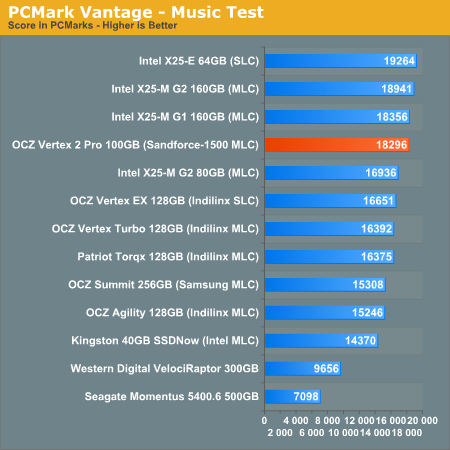
The Communications suite is made up of two tests, both involving light multitasking. The first test simulates data encryption/decryption while running message rules in Windows Mail. The second test simulates web surfing (including opening/closing tabs) in IE7, data decryption and running Windows Defender.
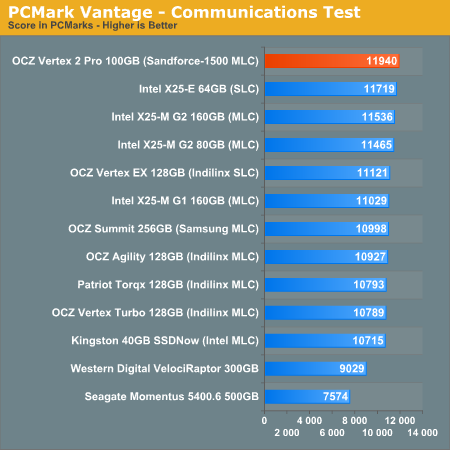
I love PCMark's Productivity test; in this test there are four tasks going on at once, searching through Windows contacts, searching through Windows Mail, browsing multiple webpages in IE7 and loading applications. This is as real world of a scenario as you get and it happens to be representative of one of the most frustrating HDD usage models - trying to do multiple things at once. There's nothing more annoying than trying to launch a simple application while you're doing other things in the background and have the load take forever.
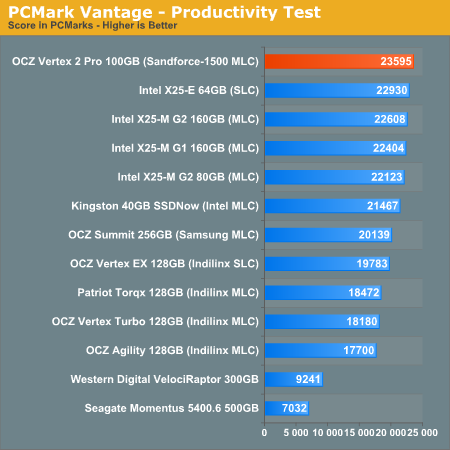
The final PCMark Vantage suite is HDD specific and this is where you'll see the biggest differences between the drives:
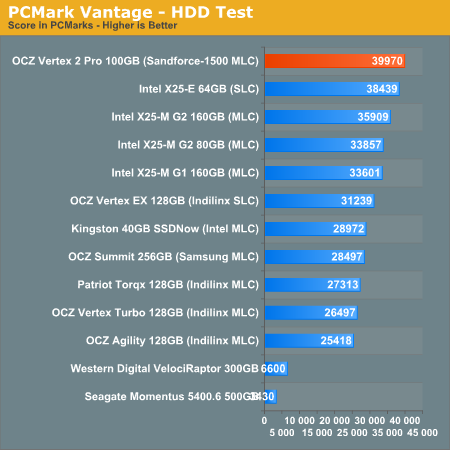










100 Comments
View All Comments
Holly - Friday, January 1, 2010 - link
Well, you can patent implementation and technology, but not the idea itself. (At least that's what my boss was trying to explain me). So, in case this idea seems worthy enough other manufacturers will come with their own MySuperStoringTechnology (c).Personaly I think any improvement (even if it comes out to be dead end) is worth it in global scale and this tech seems very interesting to me.
I only have some worries about using cheaper NAND chips... Taking cheap USB flash they tend to go nuts in about 6-12 months of usage (well, I am stressing them quite a bit...) Putting them together with the best controller seems to me a bit like disbalancing things. Definitely not for servers/enthusiasts (who want the best quality for good reasons) and still too expensive for pple earning their paychecks
Holly - Friday, January 1, 2010 - link
P.S. Happy New Yearyacoub - Thursday, December 31, 2009 - link
I don't know that I want lower-quality Flash memory in my SSDs. I think I'd rather have both a better chip and high quality memory. But you know corners will be cut somewhere to keep the prices affordable.frontliner - Thursday, December 31, 2009 - link
Page 10 talks about Random Write in MB/s and you're talking IOPS:At 11K IOPS in my desktop 4KB random write test, the Vertex 2 Pro is 20% faster than Intel’s X25-M G2. Looking at it another way, the Vertex 2 Pro has 2.3x the 4KB random write performance of today’s OCZ Vertex Turbo.
&
Random read performance is quite good at 13K IOPS, but a little lower than Intel’s X25-M G2.
Anand Lal Shimpi - Thursday, December 31, 2009 - link
woops! you're right, I decided to go with the MB/s graphs at the last minute but wrote the text based on the IOPS results. Fixed! :)Take care,
Anand
Makaveli - Thursday, December 31, 2009 - link
My guess is intel will release another firmware to increase the write speed on the G2 drives. As Q4 2010 is quite a long wait for a refresh. So new firmware with increase write speed and a price drop should still keep them in the driving seat.Kudos to OCZ for the constant shove in the back to intel tho.
mikesown - Thursday, December 31, 2009 - link
Hi Anand,Great article! Along the subject of Intel's monopoly bullying, I was curious if you had any information about Micron manufacturing their own C300 SSDs with (very nice, it seems) Marvell controllers(see http://www.micronblogs.com/category/ssd-concepts/)">http://www.micronblogs.com/category/ssd-concepts/). I know Micron and Intel manufactured NAND jointly through their IM Flash Technologies venture, so it seems a little bit strange that Micron would manufacture competing SSDs while in a partnership with Intel. Did Intel and Micron part ways for good?
Thanks,
Mike
efficientD - Thursday, December 31, 2009 - link
As an employee of Micron, I can say that Intel and Micron have not parted ways, but rather only had the agreement for the actual flash memory and not all of the other parts of an SSD (controller, dtc.) We are still very much in cooperation on what was agreed upon in the first place. You will notice that the OCZ in this article is Micron, and not from IM flash (the Intel/Micron joint venture). If you crack open an Intel drive, however, you will nearly exclusively find IM Flash chips along with Micron DRAM, the first gen didn't even have Micron DRAM. Hope this clarifies some things.Doormat - Thursday, December 31, 2009 - link
I'm disappointed in the lack of SATA 6Gb/s support, but a lot of that is product timing (its only now showing up in add-on chips, and controllers in late 2010/early 2011). You really wonder what the speeds are on an unbridled SF-based drive.Jenoin - Thursday, December 31, 2009 - link
"SandForce states that a full install of Windows 7 + Office 2007 results in 25GB of writes to the host, yet only 11GB of writes are passed on to the drive. In other words, 25GBs of files are written and available on the SSD, but only 11GB of flash is actually occupied. Clearly it’s not bit-for-bit data storage.""What SF appears to be doing is some form of real-time compression on data sent to the drive."
Based on what they said (and what they didn't say) I have to disagree. It appears to me that they are comparing the write that is requested with the data already on the SSD and only writing to the bits that need changed thereby write amplification ~0.5. This would explain the high number of IOPS during your compressed file write test perhaps. That test would then be a mixed test of sequential and random writes giving you performance numbers in between the two other tests. Could you verify the actual disk usage with windows 7 and Office installed? If it indicates 11gb used then it is using some kind of compression but if it indicates the full size on the disk then it is using something similar to what I detailed. I just thought it interesting that Sandforce never said things would take up less space, (which would be a large selling point) they only said it would have to write about half as much supporting my theory.